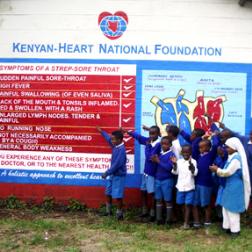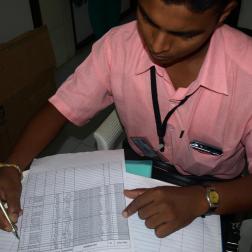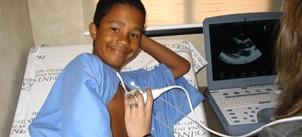Introduction
ARF and RHD are the result of social, environmental and economic conditions which predominantly occur in situations of poverty. Reducing the risk factors for GAS infection, ARF and RHD is known as primordial prevention.
Improved socio-economic status has reduced the burden of RHD in developed settings; with reduced overcrowding, improved hygiene and improved medical care RHD has been largely eliminated from these settings. Primordial prevention activities can also be undertaken as part of RHD control programs to improve the living environment for people living with ARF/ RHD and their families. This may include family-focused education on hygiene and sanitation, promoting nutritious diet, reorganising sleeping arrangements in the house to minimise the number of people sleeping in the same room and providing access to soap and water for washing clothes and bodies.
Other population level prevention strategies include research to understand the genetic and autoimmune mechanisms of ARF and RHD. Improved understanding of the disease may make it possible to develop new therapies for prevention and treatment. Development of a vaccine against group A strep infection - with potential to prevent ARF and RHD – is the most developed of these. Early diagnosis and treatment of RHD through echocardiography screening may also be an effective population prevention strategy.
Primordial prevention
RHD is rare in economically developed settings. ARF has declined where governments and their population have improved environmental conditions and provided access to resources that improve hygiene. Reducing the risk factors for GAS infection, ARF and RHD is known as primordial prevention.
Worldwide, 80% of people living with RHD are in developing countries, the remainder in vulnerable or Indigenous populations in high resource settings. ARF and RHD are the result of social, environmental and economic conditions which predominantly occur in situations of poverty.
Where access to education, infrastructure, medical facilities and care is poor, rheumatic heart disease has become a cause of morbidity, incapacity, and death. The disease affects the most productive members of society, namely those in adolescence and young adulthood. Improved socio-economic conditions and population-based prevention strategies have lowered, if not completely eradicated, levels of RHD in developed countries. Low-income and middle-income regions, such as those in sub-Saharan Africa, and vulnerable populations in high resource settings, are still highly burdened with the disease.
Economic development
Global development agenda
Sustainable Development Goals (SDGs) provide a framework to reduce global poverty. The proposed SDGs encompass 17 goals, with 169 targets focused on a broad range of sustainable development issues. There is substantial opportunity to integrate RHD into SDG targets, in particular with the mainstreaming of NCDs into the framework and within the goals.
Sustainable Development Goal 3: Ensure healthy lives and promote well-being for all ages
Proposed health goal SDG3 includes the following targets relevant to RHD and NCDs:
- 3.1 by 2030 reduce the global maternal mortality ratio to less than 70 per 100,000 live births.
< >
- 3.3 by 2030 end the epidemics of AIDS, tuberculosis, malaria, and neglected tropical diseases and combat hepatitis, water-borne diseases, and other communicable diseases.
- 3.4 by 2030 reduce by one-third premature mortality from non-communicable diseases (NCDs) through prevention and treatment, and promote mental health and wellbeing.
- 3.b support research and development of vaccines and medicines for the communicable and non-communicable diseases that primarily affect developing countries, provide access to affordable essential medicines and vaccines, in accordance with the Doha Declaration which affirms the right of developing countries to use to the full the provisions in the TRIPS agreement regarding flexibilities to protect public health and, in particular, provide access to medicines for all.
- 3.c
increase substantially health financing and the recruitment, development and training and retention of the health workforce in developing countries, especially in LDCs and SIDS.
- 3.d strengthen the capacity of all countries, particularly developing countries, for early warning, risk reduction, and management of national and global health risks.
Household Crowding
Household overcrowding is a well-established risk factor for GAS infection and ARF. Increased urbanization and population density as a result of population growth is also a risk factor. Increased urbanization and population density as a result of population growth is also a risk factor. The role of urbanization, inadequate nutrition and the other social determinants of health (including low levels of employment and education opportunities, lack of food security, poor transport infrastructure and poverty) are also likely to create enabling environments for ARF/RHD. These socioeconomic and structural issues are even more problematic in remote settings, where access to appropriate medical care and services prove difficult to assess.
Understanding genetic risks for RF and RHD
RF and RHD is more common in some families than in others. This probably reflects a combination of shared risk factors within families (overcrowding, limited access to health services) and genetic risk of RF. Understanding the role of genetics in RF may make it possible to better target treatment and prevention activities. Improved understanding of genetic risk of RF and RHD is expected in the next few years.
Current studies exploring this issue include;
- RECHARGE (Rwanda)
- Evaluating the genetic contribution to rheumatic heart disease pathogenesis in Australian Aboriginal and Torres Strait Islander communities (Australia)
- Genetic Susceptibility to Rheumatic Heart Disease in the Pacific Region (Fiji)
Development of a group A streptococcal vaccine
A vaccine against GAS offers promise for definitive control of ARF, RHD and other diseases caused by the same bacteria. Attempts to develop a GAS vaccine have been underway since the early 1920s and a number have progressed to early human trials. Progress towards a safe, effective, affordable and practical GAS vaccine has accelerated in recent years. The coalition to advance new vaccines against group A streptococcus (CANVAS) initiative, funded by the Governments of Australia and New Zealand began in 2013. A number of vaccine candidates are in early human trials.
Prioritizing, developing and implementing vaccine programs is a complex international undertaking. Similarly, basic science development of vaccines is highly specialized, expensive and technically complex. These barriers can make it difficult for local disease control programs to engage with global vaccine priority setting. In reality, countries, communities and control programs are the primary stakeholders in vaccine development. Local engagement is critical for producing a vaccine which is needed, accepted and adopted.
The importance early country level engagement is demonstrated by the rapid introduction of some vaccines (rotavirus and pneumococcal) after product licensure. Others, including HiB and Hepatitis B, experienced lengthy delays prior to widespread use. In light of these experiences WHO developed Vaccine Introduction Guidelines to help countries make decisions about new vaccines. This model has been expanded and adapted to explore preliminary work for making decisions about a malaria vaccine. A similar framework for preparatory GAS vaccine engagement is needed. In the interim key topics adapted from malaria are outlined below:
Signal vaccine demand
Identifying and communicating vaccine needs in low resource settings is critical for securing interest, funding and support from large stakeholders. Governments of endemic countries, clinicians and RHD control programs have the best possible insight into why a vaccine is needed. Collating these experiences and advocating for vaccine development is an important contribution to the vaccine development agenda.
Burden of disease data
Burden of disease data is essential for demonstrating need and to inform decisions about potential benefits, cost effectiveness and impact. Locally measured data on burden of disease has a greater impact on decision makers than international estimates.
Existing intervention data
Development of an expensive vaccine is only worthwhile if there are no simpler or easier ways to achieve the same goal. Understanding what your country and program spend on the existing interventions – and how well they work – is critical information for making vaccine investment decisions.
Echocardiographic screening
Health screening programs are designed to ’discover those among the apparently well who are in fact suffering from the disease’. Screening is a specialised issue in medicine and public health because it involves actively seeking disease in people who would otherwise be considered well. This proactive approach raises unique practical and ethical issues.
WHO have supported auscultation (stethoscope) screening of children for RHD in high risk populations since the 1970s. A WHO supported auscultation screening program began in 1984, and included 1.4 million school children in 16 countries. In 2001 the WHO Expert Committee for ARF and RHD again recommended auscultation screening for high risk populations. This search for heart murmurs represented a large scale attempt to identify children with RHD. However, the advent of echocardiography (echo) has revolutionised screening for RHD, offering risks and benefits.
In 2007, Marijon et al compared the classical approach of auscultation screening with stethoscopes to screening with portable echocardiography. Case detection of asymptomatic RHD was up to ten fold higher with echocardiography than auscultation. Rapid diffusion of portable echocardiography technology was associated with a large number of research activities to quantify the prevalence of RHD. However, without standardized diagnostic criteria comparison of echocardiography screening studies was difficult.
In 2012, Remenyi et al published the World Heart Federation for echocardiographic diagnosis of RHD, applicable to asymptomatic patients aged under 20 years. This global criteria potentiates a new era of robust and reproducible echocardiography screening. The WHF criteria created two categories of ‘definite RHD’ and ‘borderline RHD’ The natural history of borderline disease remains uncertain; a large multicenter trial is needed to understand the effect of secondary prophylaxis on mild valve lesions.
Most large scale echo projects have been conducted to provide baseline descriptive epidemiology and burden of disease data. The information and engagement from echo screening projects has been important for the growing international interest in RHD. However, the clinical application of echo screening for detecting early disease and providing opportunities for intervention remains unclear. The rapid increase in echo screening programs has prompted concern about the ethics and feasibility of screening, given these uncertainties.
Many countries have criteria to establish when population screening is appropriate, and what issues need to be considered. One of the well-known criteria are presented below:
**SUITABALITY OF RHD FOR ECHO SCREENING** (INSERT TABLE)






